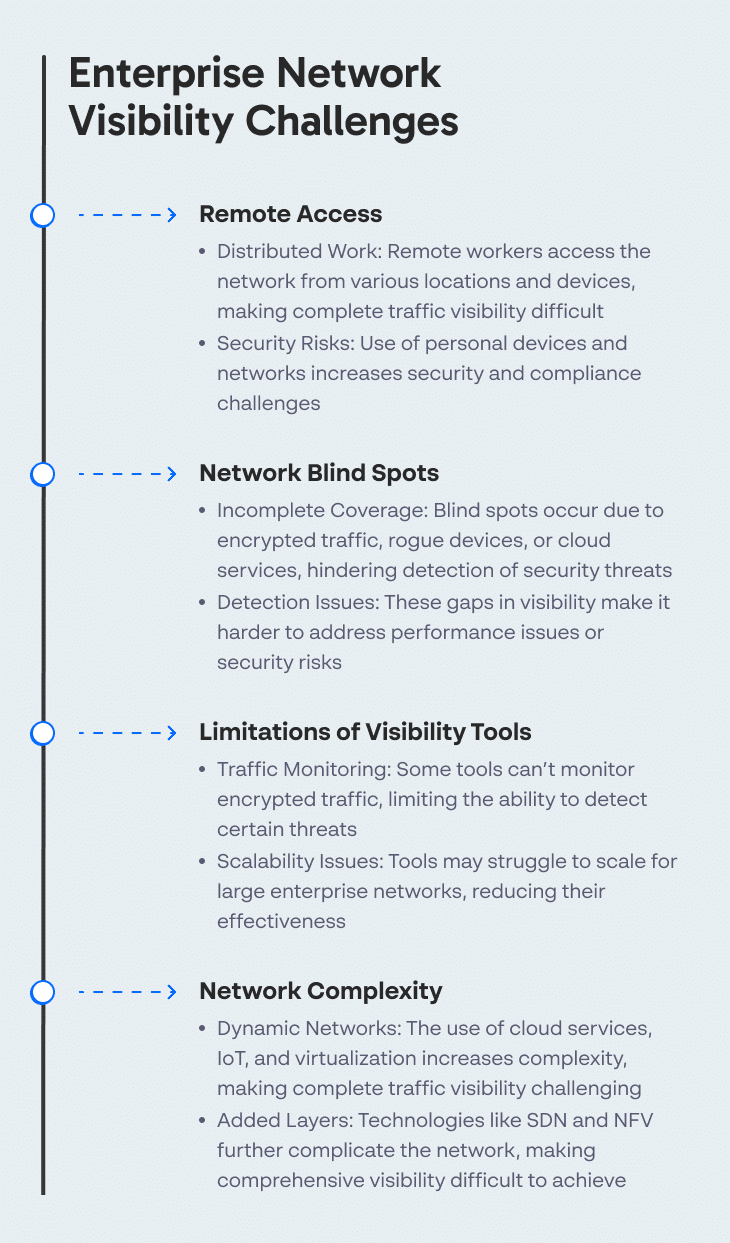Network Visibility: Challenges and Best Practices
What Is Network Visibility?
Network visibility refers to the ability to see and understand the traffic flowing through a network, including the devices, applications, and protocols that are being used, as well as the data that is being transmitted.
To achieve granular network visibility, organizations typically use a combination of hardware and software tools, such as network taps, probes, and analytics platforms. These tools can provide a detailed view of the network traffic, including information about the devices and applications that are generating the traffic, as well as the protocols and ports that are being used.
This is part of a series of articles about network attacks.
Why Network Visibility Is Important
Network visibility is important for a variety of reasons, including:
- Security: By having visibility into the network traffic, security teams can detect and respond to potential threats and vulnerabilities more quickly and effectively. Network visibility allows security teams to identify and investigate suspicious activity, such as malicious traffic, unauthorized access attempts, and other security incidents, and take the appropriate action to prevent or mitigate them.
- Network performance: By understanding the types and amounts of traffic that are flowing through the network, network administrators can identify and resolve issues that may be causing slowdowns or other performance problems. A visibility strategy allows for the identification of bottlenecks, bandwidth consumption, and other network performance issues, which can help to improve the overall performance of the network.
- Compliance: Many organizations are required to comply with various regulations and standards, such as HIPAA or PCI-DSS. Network visibility can help ensure that the organization is meeting these requirements by providing visibility into the types of data that are being transmitted and the security controls that are in place.
- Troubleshooting: Network visibility solutions can help identify the root cause of network problems and resolve them quickly, reducing downtime and improving overall network reliability. By having visibility into the network and its traffic, network administrators can quickly identify and resolve issues such as network outages, connectivity problems, and other issues that may be causing disruptions to the network.
- Business continuity: Visibility tools can also provide insight into the overall health and performance of the network, which is essential for ensuring that business-critical applications and services are available and running smoothly. This can help to ensure the continuity of business operations and minimize the potential impact of network outages or other disruptions.
Enterprise Network Visibility Challenges
There are several challenges to maintaining visibility across large, distributed networks, especially when the work environment grows and changes quickly. Here are some common challenges of network visibility.
Remote Access
With the increasing trend of remote work, it is becoming more challenging for organizations to maintain visibility into the traffic flowing through their networks. Remote workers may be accessing the network from different locations, using different devices and networks, which can make it difficult for network visibility tools to provide a complete and accurate view of the network traffic. Additionally, remote workers may be using personal devices and networks, which can introduce additional security risks and compliance challenges.
Network Blind Spots
Another challenge to network visibility is the presence of blind spots, or areas of the network where visibility tools are unable to provide complete coverage. These blind spots can be caused by a variety of factors, such as the use of encrypted traffic, the presence of rogue devices, or the use of cloud-based services. These blind spots can make it difficult for organizations to detect and respond to potential security threats and performance issues.
Limitations of Visibility Tools
Network visibility tools can have limitations in terms of the types of traffic they can monitor, the level of detail they can provide, and the scalability of the solution. For example, some visibility tools may not be able to monitor encrypted traffic, which can limit the organization’s ability to detect and respond to potential security threats.
In addition, some visibility tools may not be able to scale to meet the needs of a large enterprise network, which can limit their effectiveness in providing complete visibility.
Network Complexity
The complexity of modern enterprise networks can also present challenges for achieving network visibility. With the increasing use of cloud-based services, Internet of Things (IoT) devices, and virtualization, networks are becoming more distributed and dynamic, making it difficult for visibility tools to provide a complete and accurate view of the network traffic.
Additionally, the increasing use of software-defined networking (SDN) and network functions virtualization (NFV) can add additional layers of complexity to the network, making it difficult for visibility tools to provide a comprehensive view of the network.
Tips From Expert
In my experience, here are tips that can help you better adapt to network visibility:
- Correlate network visibility with user behavior analytics Integrating network visibility with user behavior analytics (UBA) enhances the detection of insider threats and compromised credentials. Track anomalous user patterns across applications, cloud services, and endpoints for deeper insights.
- Utilize encrypted traffic analysis (ETA) Even if traffic is encrypted, modern ETA solutions can detect malicious patterns without decrypting the content. This ensures visibility into encrypted traffic flows, helping to monitor threats hidden within secure communications.
- Monitor east-west traffic within data centers Many organizations focus solely on north-south (incoming/outgoing) traffic, neglecting east-west traffic (lateral movement within data centers). Ensuring visibility into lateral movement is crucial for detecting advanced threats like APTs.
- Integrate visibility tools with SOAR for automation Connecting network visibility tools to Security Orchestration, Automation, and Response (SOAR) platforms can help automate the correlation of network events, allowing faster and more efficient incident detection and response.
- Maintain visibility in remote and mobile environments Extend network visibility to remote users by deploying endpoint detection on VPN or Zero Trust solutions. This ensures visibility over traffic even when users access the network from personal or remote devices.
How to Achieve Network Visibility
Consistent Data Collection
By collecting detailed data on the traffic flowing through the network, organizations can gain a better understanding of the devices, applications, and protocols that are being used, as well as the data that is being transmitted. This can help organizations to identify and investigate potential security threats, performance issues, and compliance issues more quickly and effectively.
Effective, reliable data collection can be achieved through the use of hardware and software tools, such as network taps and probes, that can provide a detailed view of the network traffic. These tools can be placed at key locations within the network, such as at the edge of the network, to provide a complete view of the traffic flowing in and out of the network.
Additionally, organizations can use network analytics platforms to collect, analyze and visualize the data, and provide real-time visibility into the traffic patterns and behaviors across the network. These platforms can use machine learning and other techniques to identify potential threats and performance issues, helping organizations to take proactive measures to prevent or mitigate them.
Expert Threat Analysis
Expert-assisted threat analysis is a process that uses the expertise and knowledge of security professionals to analyze network traffic and identify potential security threats. This can help organizations to achieve network visibility by providing a deeper understanding of the types of threats that are present on the network, and the tactics, techniques and procedures (TTPs) that are being used by attackers.
Actionable Alerts
Contextual, easy-to-understand alerts can help organizations achieve network visibility by providing actionable information that allows them to quickly identify and respond to potential security threats, performance issues, and compliance issues.
Contextual alerts provide information about the specific event or condition that triggered the alert, such as the device, application, or protocol that was involved. This can help organizations to quickly understand the nature of the alert and take the appropriate action. For example, if an alert is triggered by a device trying to connect to a known malicious IP address, the alert would provide details about the device, the IP address and the type of connection.
It is also important that alerts can be quickly understood by the personnel responsible for managing the network, regardless of their technical expertise. This can help to ensure that alerts are acted upon quickly, reducing the risk of a security incident or network disruption.
Securing Your Network with Cynet
Cynet helps detect network security threats, correlating data from endpoints, network analytics and behavioral analytics to present findings with near-zero false positives. Cynet captures and analyzes network-based telemetry to identify and stop threats such as port scanning, DNS attacks and tunnel exfiltration. As an additional layer of network defense, Cynet utilizes deception technology to lure attackers into revealing their presence on the network.
Unlike other XDR providers, which either do not offer network threat detection or that require an additional license, Cynet natively incorporates these capabilities into its XDR offering.
Related Posts
Looking for a powerful, cost effective XDR solution?
- Full-Featured XDR, EDR, and NGAV
- Anti-Ransomware & Threat Hunting
- 24×7 Managed Detection and Response




